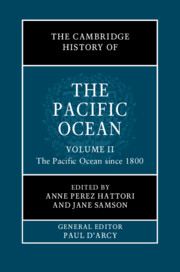Book contents
- The Cambridge History of the Pacific Ocean
- The Cambridge History of the Pacific Ocean
- The Cambridge History of the Pacific Ocean
- Copyright page
- Contents
- Figures
- Tables
- Contributors to Volume II
- Frontispiece
- General Editor’s Introduction
- Preface to Volume II
- Part VII Rethinking the Pacific
- Part VIII Approaches, Sources, and Subaltern Histories of the Modern Pacific
- Part IX Culture Contact and the Impact of Pre-colonial European Influences
- 44 The Pacific in the Age of Revolutions
- 45 Disease in Pacific History
- 46 The Culture Concept and Christian Missions in the Pacific
- 47 Trading Nature in the Pacific
- 48 Seaborne Ethnography to the Science of Race, 1521–1850
- Part X The Colonial Era in the Pacific
- Part XI The Pacific Century?
- Part XII Pacific Futures
- References to Volume II
- Index
48 - Seaborne Ethnography to the Science of Race, 1521–1850
from Part IX - Culture Contact and the Impact of Pre-colonial European Influences
Published online by Cambridge University Press: 11 November 2022
- The Cambridge History of the Pacific Ocean
- The Cambridge History of the Pacific Ocean
- The Cambridge History of the Pacific Ocean
- Copyright page
- Contents
- Figures
- Tables
- Contributors to Volume II
- Frontispiece
- General Editor’s Introduction
- Preface to Volume II
- Part VII Rethinking the Pacific
- Part VIII Approaches, Sources, and Subaltern Histories of the Modern Pacific
- Part IX Culture Contact and the Impact of Pre-colonial European Influences
- 44 The Pacific in the Age of Revolutions
- 45 Disease in Pacific History
- 46 The Culture Concept and Christian Missions in the Pacific
- 47 Trading Nature in the Pacific
- 48 Seaborne Ethnography to the Science of Race, 1521–1850
- Part X The Colonial Era in the Pacific
- Part XI The Pacific Century?
- Part XII Pacific Futures
- References to Volume II
- Index
Summary
This chapter investigates the production of varied European knowledges about the Indigenous inhabitants of the insular Pacific from the early sixteenth to the mid-nineteenth centuries. I address liaisons of two entwined cognitive modes glossed as ‘facts’ and ‘systems’ – terms borrowed from the French comparative anatomist Cuvier, who condemned ‘systems’ conceived ‘in the study’ while vaunting ‘the more solid edifice of facts and induction’.1 ‘Facts’ denotes ‘seaborne ethnography’:2 written, drawn, or toponymic outcomes of fleeting encounters with Pacific Islanders by European voyagers unfamiliar with their languages, practices, or ideas. ‘Systems’ refers to both the deductive appropriations of such information by savants in Europe from the 1740s and the inductive reflections of travelling naturalists after 1770. My scientific focus is partly ‘geographic’, identifying cartographic residues of encounters in place. However, it is mainly ‘anthropological’, surveying the deployment of seaborne ethnography in diverse, shifting explanations for human difference proposed in the ‘science of man’.
- Type
- Chapter
- Information
- The Cambridge History of the Pacific Ocean , pp. 389 - 420Publisher: Cambridge University PressPrint publication year: 2023



